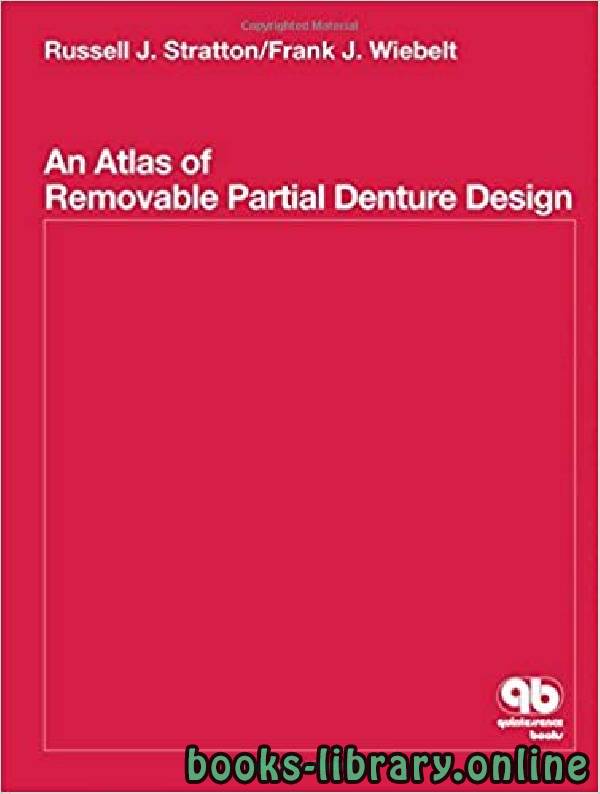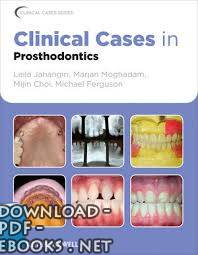كتاب Atlas of Removable Partial Denture
Atlas of Removable Partial Denture by Russell J. Stratton JOHN A. YAGIELA, DDS, PhD In this work on partial denture design, part I covers basic principles and the rationale of denture design, while part II describes and illustrates designs for 250 of the most common partially edentulous arches. A standard design is presented, and possible variations are discussed. Contributors Peter W. Abel, PhD Professor, Department of Pharmacology School of Medicine Creighton University Omaha, Nebraska Jeffrey D. Bennett, DMD Professor and Chair Department of Oral Surgery and Hospital Dentistry vii Preface HOW TO APPROACH PHARMACOLOGY Although pharmacology can be considered a basic science, the ultimate purpose of pharmacology in the health science setting is to apply basic principles to clinical practice. This book, which is targeted to the dental student and dental practitioner, is designed to meet that need. Pharmacology is important to the dentist not only because of the drugs that he or she prescribes or uses in the dental office, but also because of other drugs that the patient takes. Every drug can affect the entire body. Moreover, when more than one drug is given concurrently, there is a potential for drug interactions that could have adverse consequences. This book is designed to make specific dental applications to each drug class. Included in this information are the benefits and risks associated with those drug classes. In the study of pharmacology it is important to learn drugs by their class on the basis of similarity of mechanism of action, not as individual stand-alone medications. Thus armed with the knowledge of the properties of a class of drugs and examples of drugs within that class, one can streamline the learning process. Organization of drug information can then be arranged around the following subcategories. (These will be useful in studying most drugs.) 1. Name of drug class and examples 2. Mechanism of action 3. Pharmacokinetics 4. Indications 5. Adverse effects 6. Contraindications 7. Miscellaneous information, including drug interactions 8. Implications for dentistry Some devices can help in the learning of drug names. The nonproprietary (generic) names for drugs within a given class often have similarities. Being familiar with a list of suffixes of generic drug names can be helpful in identifying an individual drug. Such a list is given below. SUFFIXES AS CUES FOR REMEMBERING DRUG CLASSES SUFFIX DRUG CLASS EXAMPLE “azole” Azole-type antifungal drug or Antibacterial-antiparasitic drug Fluconazole Metronidazole “caine” Local anesthetic Lidocaine “coxib” Cyclooxygenase-2 (COX-2) inhibitor Celecoxib “dipine” Dihydropyridine Ca++ channel blocker Nifedipine “ilol” or “alol” β-Adrenergic receptor blocker that also the blocks the α1-adrenergic receptor Carvedilol, labetalol “mab” Monoclonal antibody Infliximab “olol” β-Adrenergic receptor blocker Propranolol “onium” or “urium” Quaternary ammonium compound, usually used as a peripheral competitive skeletal muscle relaxer Pancuronium, atracurium “osin” α1-Adrenergic receptor blocker Prazosin “pam” or “lam” Benzodiazepine antiaxiety agent or sedative hypnotic Diazepam, triazolam “pril” or “prilat” Angiotensin-converting enzyme (ACE) inhibitor Captopril “sartan” Angiotensin II receptor blocker Losartan “statin” HMG CoA reductase inhibitor anti-lipid drug Lovastatin “triptan” Serotonin 5-HT1B/1D agonist antimigraine drug Sumatriptan “vir” Antiviral drug Acyclovir Application of information to clinical cases can increase retention and appreciation of pharmacology. For instance, suppose that a dental patient has been prescribed darifenacin by his or her physician to treat urinary urgency. One should know that drugs such as darifenacin are likely to cause xerostomia (dry mouth), and one should know why. Therefore it is reasonable to assume that xerostomia would be a likely complaint that a patient would have after taking such a drug. Moreover, it would also be well to consider how a dentist can help relieve symptoms of xerostomia without compromising the treatment for urinary urgency. This thought process requires knowledge of how these drugs act, including the receptors involved, and what responses are linked to these receptors. The landscape of pharmacology is ever expanding with the constant development of new drugs, new drug classes, and new information on older drugs. Furthermore, the growth in our knowledge in areas such as pharmacogenetics and pharmacogenomics promises to lead to the practice of tailoring drug therapy to the individual. All in all, pharmacology is an exciting and dynamic discipline. This book covers the major areas of pharmacology and provides an intellectual framework on which to use drugs in a rational manner. This ebook is uploaded by dentalebooks.com Contents PART I Principles of Pharmacology 1 Pharmacodynamics: Mechanisms of Drug Action, 2 John A. Yagiela 2 Pharmacokinetics: The Absorption, Distribution, and Fate of Drugs, 17 John A. Yagiela 3 Pharmacotherapeutics: The Clinical Use of Drugs, 48 John A. Yagiela and Frank J. Dowd 4 Pharmacogenetics and Pharmacogenomics, 69 David W. Hein and Denis M. Grant PART II Pharmacology of Specific Drug Groups 5 Introduction to Autonomic Nervous System Drugs, 78 Peter W. Abel and Michael T. Piascik 6 Adrenergic Agonists, 91 Yaping Tu, Michael T. Piascik, and Peter W. Abel 7 Adrenergic Antagonists, 106 Michael T. Piascik and Peter W. Abel 8 Cholinergic Drugs, 117 Frank J. Dowd 9 Antimuscarinic Drugs, 129 Frank J. Dowd 10 Drugs Affecting Nicotinic Receptors, 136 Xi-Qin Ding 11 Introduction to Central Nervous System Drugs, 149 Vahn A. Lewis 12 Psychopharmacology: Antipsychotic and Antidepressant Drugs, 162 Vahn A. Lewis 13 Sedative-Hypnotics, Antianxiety Drugs, and Centrally Acting Muscle Relaxants, 188 Joseph A. Giovannitti, Jr., and Paul A. Moore 14 Anticonvulsants, 212 Vahn A. Lewis 15 Anti-Parkinson Drugs, 230 Vahn A. Lewis 16 Local Anesthetics, 246 John A. Yagiela 17 Principles of General Anesthesia, 266 John A. Yagiela and Daniel A. Haas 18 Agents Used in General Anesthesia and Sedation, 281 Daniel A. Haas and John A. Yagiela 19 Introduction to Antinociceptive Drugs, 299 Hyungsuk Kim and Raymond A. Dionne 20 Opioid Analgesics and Antagonists, 307 Michael H. Ossipov, Gerald F. Gebhart, and Frank Porreca 21 Nonopioid Analgesics, Nonsteroidal Anti-inflammatory Drugs, and Antirheumatic and Antigout Drugs, 324 Elliot V. Hersh , Paul J. Desjardins, Clarence L. Trummel, and Stephen A. Cooper 22 Histamine and Histamine Antagonists, 359 Clarence L. Trummel 23 Drugs for Treating Orofacial Pain Syndromes, 373 Robert L. Merrill 24 Antiarrhythmic Drugs, 393 Frank J. Dowd 25 Drugs Used in H PHARMACOLOGY-
من كتب طب الأسنان - مكتبة كتب الطب.

قراءة كتاب Atlas of Removable Partial Denture أونلاين
معلومات عن كتاب Atlas of Removable Partial Denture:
by Russell J. Stratton
JOHN A. YAGIELA, DDS, PhD
In this work on partial denture design, part I covers basic principles and the rationale of denture design, while part II describes and illustrates designs for 250 of the most common partially edentulous arches. A standard design is presented, and possible variations are discussed.
Contributors
Peter W. Abel, PhD
Professor, Department of Pharmacology
School of Medicine
Creighton University
Omaha, Nebraska
Jeffrey D. Bennett, DMD
Professor and Chair
Department of Oral Surgery and Hospital
Dentistry
vii
Preface
HOW TO APPROACH PHARMACOLOGY
Although pharmacology can be considered a basic science,
the ultimate purpose of pharmacology in the health science
setting is to apply basic principles to clinical practice. This
book, which is targeted to the dental student and dental practitioner,
is designed to meet that need. Pharmacology is
important to the dentist not only because of the drugs that
he or she prescribes or uses in the dental office, but also
because of other drugs that the patient takes. Every drug can
affect the entire body. Moreover, when more than one drug
is given concurrently, there is a potential for drug interactions
that could have adverse consequences.
This book is designed to make specific dental applications
to each drug class. Included in this information are the
benefits and risks associated with those drug classes.
In the study of pharmacology it is important to learn drugs
by their class on the basis of similarity of mechanism of action,
not as individual stand-alone medications. Thus armed with
the knowledge of the properties of a class of drugs and
examples of drugs within that class, one can streamline the
learning process. Organization of drug information can
then be arranged around the following subcategories. (These
will be useful in studying most drugs.)
1. Name of drug class and examples
2. Mechanism of action
3. Pharmacokinetics
4. Indications
5. Adverse effects
6. Contraindications
7. Miscellaneous information, including drug interactions
8. Implications for dentistry
Some devices can help in the learning of drug names. The
nonproprietary (generic) names for drugs within a given class
often have similarities. Being familiar with a list of suffixes of
generic drug names can be helpful in identifying an individual
drug. Such a list is given below.
SUFFIXES AS CUES FOR REMEMBERING
DRUG CLASSES
SUFFIX DRUG CLASS EXAMPLE
“azole” Azole-type antifungal drug
or
Antibacterial-antiparasitic
drug
Fluconazole
Metronidazole
“caine” Local anesthetic Lidocaine
“coxib” Cyclooxygenase-2 (COX-2)
inhibitor
Celecoxib
“dipine” Dihydropyridine Ca++ channel
blocker
Nifedipine
“ilol” or “alol” β-Adrenergic receptor blocker
that also the blocks the
α1-adrenergic receptor
Carvedilol,
labetalol
“mab” Monoclonal antibody Infliximab
“olol” β-Adrenergic receptor blocker Propranolol
“onium” or
“urium”
Quaternary ammonium
compound, usually used as
a peripheral competitive
skeletal muscle relaxer
Pancuronium,
atracurium
“osin” α1-Adrenergic receptor
blocker
Prazosin
“pam” or “lam” Benzodiazepine antiaxiety
agent or sedative hypnotic
Diazepam,
triazolam
“pril” or “prilat” Angiotensin-converting
enzyme (ACE) inhibitor
Captopril
“sartan” Angiotensin II receptor
blocker
Losartan
“statin” HMG CoA reductase
inhibitor anti-lipid drug
Lovastatin
“triptan” Serotonin 5-HT1B/1D agonist
antimigraine drug
Sumatriptan
“vir” Antiviral drug Acyclovir
Application of information to clinical cases can increase
retention and appreciation of pharmacology. For instance,
suppose that a dental patient has been prescribed darifenacin
by his or her physician to treat urinary urgency. One should
know that drugs such as darifenacin are likely to cause xerostomia
(dry mouth), and one should know why. Therefore it
is reasonable to assume that xerostomia would be a likely
complaint that a patient would have after taking such a drug.
Moreover, it would also be well to consider how a dentist can
help relieve symptoms of xerostomia without compromising
the treatment for urinary urgency. This thought process
requires knowledge of how these drugs act, including the
receptors involved, and what responses are linked to these
receptors.
The landscape of pharmacology is ever expanding with
the constant development of new drugs, new drug classes, and
new information on older drugs. Furthermore, the growth in
our knowledge in areas such as pharmacogenetics and pharmacogenomics
promises to lead to the practice of tailoring
drug therapy to the individual.
All in all, pharmacology is an exciting and dynamic discipline.
This book covers the major areas of pharmacology and
provides an intellectual framework on which to use drugs in
a rational manner.
This ebook is uploaded by dentalebooks.com
Contents
PART I
Principles of Pharmacology
1 Pharmacodynamics: Mechanisms of Drug
Action, 2
John A. Yagiela
2 Pharmacokinetics: The Absorption,
Distribution, and Fate of Drugs, 17
John A. Yagiela
3 Pharmacotherapeutics: The Clinical Use
of Drugs, 48
John A. Yagiela and Frank J. Dowd
4 Pharmacogenetics and Pharmacogenomics, 69
David W. Hein and Denis M. Grant
PART II
Pharmacology of Specific
Drug Groups
5 Introduction to Autonomic Nervous System
Drugs, 78
Peter W. Abel and Michael T. Piascik
6 Adrenergic Agonists, 91
Yaping Tu, Michael T. Piascik, and Peter W. Abel
7 Adrenergic Antagonists, 106
Michael T. Piascik and Peter W. Abel
8 Cholinergic Drugs, 117
Frank J. Dowd
9 Antimuscarinic Drugs, 129
Frank J. Dowd
10 Drugs Affecting Nicotinic Receptors, 136
Xi-Qin Ding
11 Introduction to Central Nervous System
Drugs, 149
Vahn A. Lewis
12 Psychopharmacology: Antipsychotic
and Antidepressant Drugs, 162
Vahn A. Lewis
13 Sedative-Hypnotics, Antianxiety Drugs,
and Centrally Acting Muscle Relaxants, 188
Joseph A. Giovannitti, Jr., and Paul A. Moore
14 Anticonvulsants, 212
Vahn A. Lewis
15 Anti-Parkinson Drugs, 230
Vahn A. Lewis
16 Local Anesthetics, 246
John A. Yagiela
17 Principles of General Anesthesia, 266
John A. Yagiela and Daniel A. Haas
18 Agents Used in General Anesthesia
and Sedation, 281
Daniel A. Haas and John A. Yagiela
19 Introduction to Antinociceptive Drugs, 299
Hyungsuk Kim and Raymond A. Dionne
20 Opioid Analgesics and Antagonists, 307
Michael H. Ossipov, Gerald F. Gebhart,
and Frank Porreca
21 Nonopioid Analgesics, Nonsteroidal
Anti-inflammatory Drugs, and
Antirheumatic and Antigout Drugs, 324
Elliot V. Hersh , Paul J. Desjardins, Clarence L. Trummel,
and Stephen A. Cooper
22 Histamine and Histamine Antagonists, 359
Clarence L. Trummel
23 Drugs for Treating Orofacial Pain
Syndromes, 373
Robert L. Merrill
24 Antiarrhythmic Drugs, 393
Frank J. Dowd
25 Drugs Used in H
PHARMACOLOGY
سنة النشر : 1988م / 1408هـ .
عدد مرات التحميل : 15020 مرّة / مرات.
تم اضافته في : الجمعة , 23 فبراير 2018م.
حجم الكتاب عند التحميل : 28.3 ميجا بايت .
تعليقات ومناقشات حول الكتاب:
التعويضات السنية Prosthodontics وتشمل
الجسور الثابتة Fixed bridges والزرعات Implants
الطقوم الكاملة المتحركة removable complete denture
الطقوم الجزئية المتحركة removable partial denture
معالجة و إصلاح الأسنان Operative Dentistry وتشمل:
تشخيص تسوس الأسنان caries diagnosis
الوقايه والحد من انتشار تسوس الاسنان management of dental caries
تبييض الأسنان Dentalbleaching
تجميل الأسنان cosmetic dentistry
حشوات الأسنان Dental Fillings
معالجة لب الأسنان Endodontics
معالجة الأسنان المجهرية microscopic endodontics
طب الأسنان الوقائي Preventive Dentistry
تقويم الأسنان Orthodontics
جراحة الفم والوجه والفكين Oral and Maxillofacial Surgery
طب أسنان الأطفال Pedodontics
أمراض اللثة
أمراض الأنسجة المحيطة بالأسنان Periodontics
زراعة الأسنان Dental Implantology
أشعة الأسنان Dental Radiology
طب الأسنان الشرعي Forensic Dentistry
طب الفم Oral Medicine
أمراض الفم Oral Pathology
أنسجة الفم والأسنان Oral Histology
المادة السنية Dental material
تشريح الأسنانDental anatomy
مواضيع متعلقة بطب الأسنان
طب الأسنان للرضع
جراحة الأسنان
أسنان
طقم أسنان
طب الاسنان في الاردن
طب الأسنان في جميع أنحاء العالم
Atlas of Removable Partial Denture
JOHN A. YAGIELA, DDS, PhD
Contributors
Peter W. Abel, PhD
Professor, Department of Pharmacology
School of Medicine
Creighton University
Omaha, Nebraska
Jeffrey D. Bennett, DMD
Professor and Chair
Department of Oral Surgery and Hospital
Dentistry
vii
Preface
HOW TO APPROACH PHARMACOLOGY
Although pharmacology can be considered a basic science,
the ultimate purpose of pharmacology in the health science
setting is to apply basic principles to clinical practice. This
book, which is targeted to the dental student and dental practitioner,
is designed to meet that need. Pharmacology is
important to the dentist not only because of the drugs that
he or she prescribes or uses in the dental office, but also
because of other drugs that the patient takes. Every drug can
affect the entire body. Moreover, when more than one drug
is given concurrently, there is a potential for drug interactions
that could have adverse consequences.
This book is designed to make specific dental applications
to each drug class. Included in this information are the
benefits and risks associated with those drug classes.
In the study of pharmacology it is important to learn drugs
by their class on the basis of similarity of mechanism of action,
not as individual stand-alone medications. Thus armed with
the knowledge of the properties of a class of drugs and
examples of drugs within that class, one can streamline the
learning process. Organization of drug information can
then be arranged around the following subcategories. (These
will be useful in studying most drugs.)
1. Name of drug class and examples
2. Mechanism of action
3. Pharmacokinetics
4. Indications
5. Adverse effects
6. Contraindications
7. Miscellaneous information, including drug interactions
8. Implications for dentistry
Some devices can help in the learning of drug names. The
nonproprietary (generic) names for drugs within a given class
often have similarities. Being familiar with a list of suffixes of
generic drug names can be helpful in identifying an individual
drug. Such a list is given below.
SUFFIXES AS CUES FOR REMEMBERING
DRUG CLASSES
SUFFIX DRUG CLASS EXAMPLE
“azole” Azole-type antifungal drug
or
Antibacterial-antiparasitic
drug
Fluconazole
Metronidazole
“caine” Local anesthetic Lidocaine
“coxib” Cyclooxygenase-2 (COX-2)
inhibitor
Celecoxib
“dipine” Dihydropyridine Ca++ channel
blocker
Nifedipine
“ilol” or “alol” β-Adrenergic receptor blocker
that also the blocks the
α1-adrenergic receptor
Carvedilol,
labetalol
“mab” Monoclonal antibody Infliximab
“olol” β-Adrenergic receptor blocker Propranolol
“onium” or
“urium”
Quaternary ammonium
compound, usually used as
a peripheral competitive
skeletal muscle relaxer
Pancuronium,
atracurium
“osin” α1-Adrenergic receptor
blocker
Prazosin
“pam” or “lam” Benzodiazepine antiaxiety
agent or sedative hypnotic
Diazepam,
triazolam
“pril” or “prilat” Angiotensin-converting
enzyme (ACE) inhibitor
Captopril
“sartan” Angiotensin II receptor
blocker
Losartan
“statin” HMG CoA reductase
inhibitor anti-lipid drug
Lovastatin
“triptan” Serotonin 5-HT1B/1D agonist
antimigraine drug
Sumatriptan
“vir” Antiviral drug Acyclovir
Application of information to clinical cases can increase
retention and appreciation of pharmacology. For instance,
suppose that a dental patient has been prescribed darifenacin
by his or her physician to treat urinary urgency. One should
know that drugs such as darifenacin are likely to cause xerostomia
(dry mouth), and one should know why. Therefore it
is reasonable to assume that xerostomia would be a likely
complaint that a patient would have after taking such a drug.
Moreover, it would also be well to consider how a dentist can
help relieve symptoms of xerostomia without compromising
the treatment for urinary urgency. This thought process
requires knowledge of how these drugs act, including the
receptors involved, and what responses are linked to these
receptors.
The landscape of pharmacology is ever expanding with
the constant development of new drugs, new drug classes, and
new information on older drugs. Furthermore, the growth in
our knowledge in areas such as pharmacogenetics and pharmacogenomics
promises to lead to the practice of tailoring
drug therapy to the individual.
All in all, pharmacology is an exciting and dynamic discipline.
This book covers the major areas of pharmacology and
provides an intellectual framework on which to use drugs in
a rational manner.
This ebook is uploaded by dentalebooks.com
Contents
PART I
Principles of Pharmacology
1 Pharmacodynamics: Mechanisms of Drug
Action, 2
John A. Yagiela
2 Pharmacokinetics: The Absorption,
Distribution, and Fate of Drugs, 17
John A. Yagiela
3 Pharmacotherapeutics: The Clinical Use
of Drugs, 48
John A. Yagiela and Frank J. Dowd
4 Pharmacogenetics and Pharmacogenomics, 69
David W. Hein and Denis M. Grant
PART II
Pharmacology of Specific
Drug Groups
5 Introduction to Autonomic Nervous System
Drugs, 78
Peter W. Abel and Michael T. Piascik
6 Adrenergic Agonists, 91
Yaping Tu, Michael T. Piascik, and Peter W. Abel
7 Adrenergic Antagonists, 106
Michael T. Piascik and Peter W. Abel
8 Cholinergic Drugs, 117
Frank J. Dowd
9 Antimuscarinic Drugs, 129
Frank J. Dowd
10 Drugs Affecting Nicotinic Receptors, 136
Xi-Qin Ding
11 Introduction to Central Nervous System
Drugs, 149
Vahn A. Lewis
12 Psychopharmacology: Antipsychotic
and Antidepressant Drugs, 162
Vahn A. Lewis
13 Sedative-Hypnotics, Antianxiety Drugs,
and Centrally Acting Muscle Relaxants, 188
Joseph A. Giovannitti, Jr., and Paul A. Moore
14 Anticonvulsants, 212
Vahn A. Lewis
15 Anti-Parkinson Drugs, 230
Vahn A. Lewis
16 Local Anesthetics, 246
John A. Yagiela
17 Principles of General Anesthesia, 266
John A. Yagiela and Daniel A. Haas
18 Agents Used in General Anesthesia
and Sedation, 281
Daniel A. Haas and John A. Yagiela
19 Introduction to Antinociceptive Drugs, 299
Hyungsuk Kim and Raymond A. Dionne
20 Opioid Analgesics and Antagonists, 307
Michael H. Ossipov, Gerald F. Gebhart,
and Frank Porreca
21 Nonopioid Analgesics, Nonsteroidal
Anti-inflammatory Drugs, and
Antirheumatic and Antigout Drugs, 324
Elliot V. Hersh , Paul J. Desjardins, Clarence L. Trummel,
and Stephen A. Cooper
22 Histamine and Histamine Antagonists, 359
Clarence L. Trummel
23 Drugs for Treating Orofacial Pain
Syndromes, 373
Robert L. Merrill
24 Antiarrhythmic Drugs, 393
Frank J. Dowd
25 Drugs Used in H
PHARMACOLOGY
كتب طب اسنان
كتب طبية باللغة العربية pdf
كتب طب اسنان مترجمة
كتب تقويم اسنان بالعربي
كتب طب الاسنان في مصر
كتب طب اسنان بالعربي pdf
البسيط في تقويم الأسنان pdf
كتب طب اسنان سنة اولى
تحميل كتب في تقويم الاسنان
 مهلاً !
مهلاً !قبل تحميل الكتاب .. يجب ان يتوفر لديكم برنامج تشغيل وقراءة ملفات pdf
يمكن تحميلة من هنا 'تحميل البرنامج'

نوع الكتاب : pdf.
اذا اعجبك الكتاب فضلاً اضغط على أعجبني و يمكنك تحميله من هنا:


كتب اخرى في كتب طب الأسنان
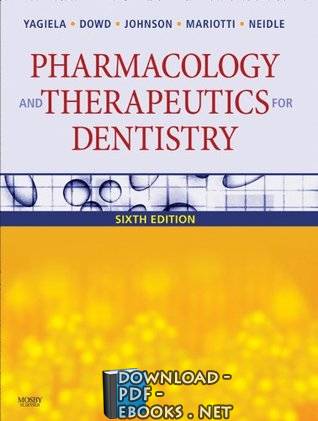
Pharmacology and Therapeutics for Dentistry PDF
قراءة و تحميل كتاب Pharmacology and Therapeutics for Dentistry PDF مجانا

Fundamentals of Fixed Prosthodontics Fourth Edition PDF
قراءة و تحميل كتاب Fundamentals of Fixed Prosthodontics Fourth Edition PDF مجانا
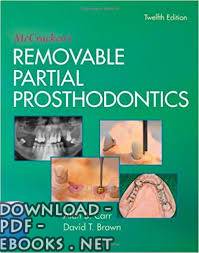
McCracken's Removable Partial Prosthodontics PDF
قراءة و تحميل كتاب McCracken's Removable Partial Prosthodontics PDF مجانا
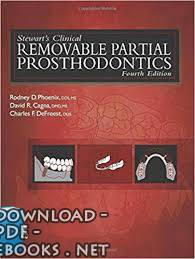
STEWART’S CLINICAL REMOVABLE PARTIAL PROSTHODONTICS Fourth Edition PDF
قراءة و تحميل كتاب STEWART’S CLINICAL REMOVABLE PARTIAL PROSTHODONTICS Fourth Edition PDF مجانا
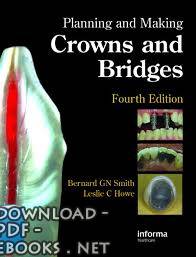
Planning and Making Crowns and Bridges PDF
قراءة و تحميل كتاب Planning and Making Crowns and Bridges PDF مجانا
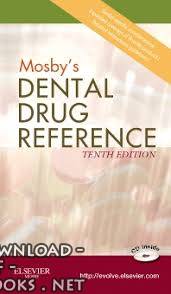
MOSBY’S DENTAL DRUG REFERENCE TENTH EDITION PDF
قراءة و تحميل كتاب MOSBY’S DENTAL DRUG REFERENCE TENTH EDITION PDF مجانا

Dental Drug Reference with Clinical Implications PDF
قراءة و تحميل كتاب Dental Drug Reference with Clinical Implications PDF مجانا
